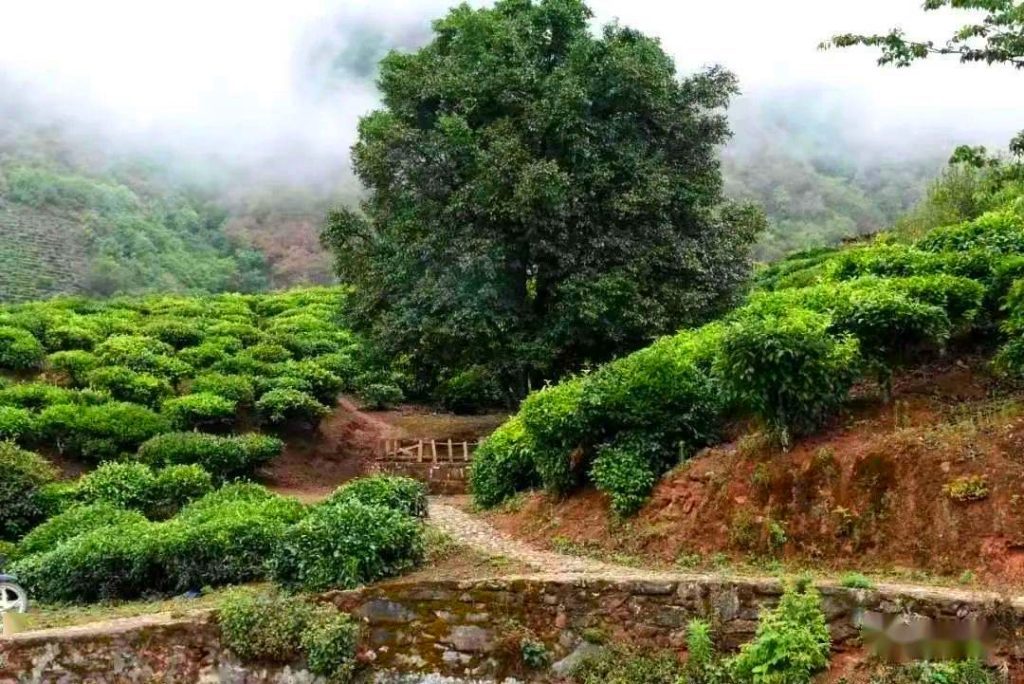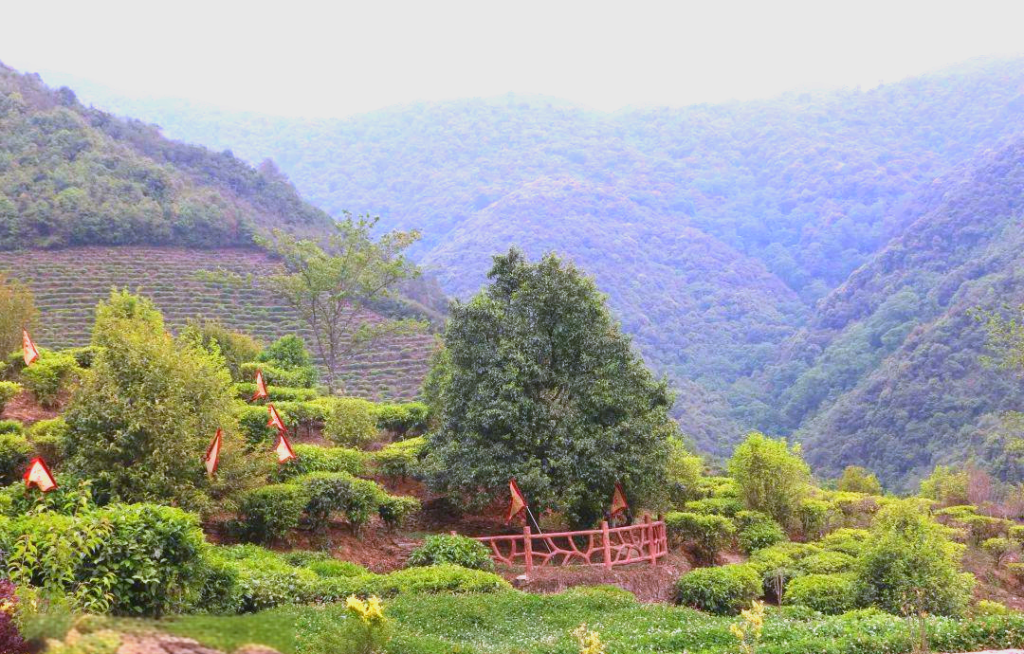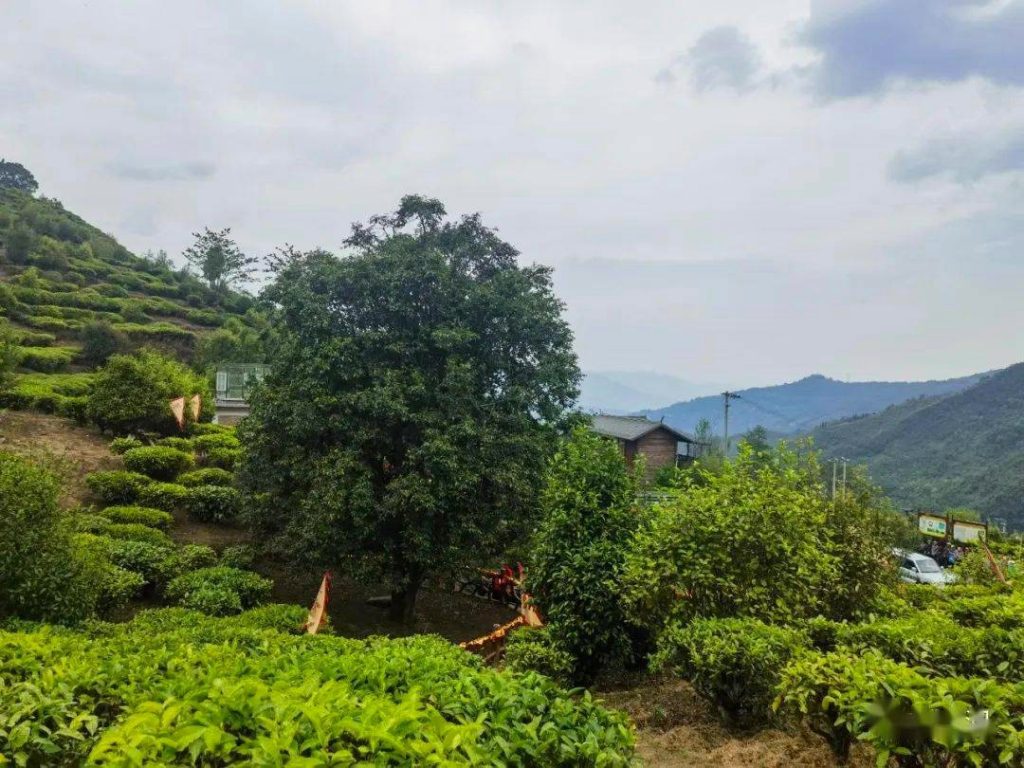Xiaogude Tea Garden of Wuliang Mountain in Nanjian County, Dali
Chinese Name: 南涧县无量山镇古德茶园
English Name:XiaoGude Tea Mountain in Nanjian County, Dali
Location:南涧县无量山镇小古德村子
XiaoGude Tea Garden (小古德茶园) lies at the heart of Wuliangshan Town (无量山镇), located within Nanjian County (南涧县), part of the Dali Bai Autonomous Prefecture (大理白族自治州). The region has long been a cradle for tea cultivation, and XiaoGude Village (小古德村) serves as a testament to this deep-rooted tradition.
The Wuliang Mountains (无量山), home to this tea garden, are famous for their excellent climate and fertile soils, which create the ideal conditions for growing high-quality tea. The ancient tea trees here are considered some of the best in China, with the most famous being the “Thousand-Year Tea King” (千年茶王), a tree that has stood the test of time for over 1,200 years.
Traditional Tea Culture
Tea culture in XiaoGude Village is an inseparable part of the local lifestyle. The cultivation, preparation, and consumption of tea have been an integral part of the region for centuries. Wuliangshan Town is renowned for its exceptional tea varieties, and the village plays a key role in the broader Yunnan tea industry.
The “Thousand-Year Tea King”
The “Thousand-Year Tea King” stands as the crown jewel of the garden. This magnificent tree, believed to be over 1,200 years old, is a cultivated species of Yunnan big leaf tea (云南大叶茶), known for its robust flavor and exceptional longevity. The tree’s height of 16 meters and its sprawling canopy make it a sight to behold.
Fascinating Features:
-
Age: Over 1,200 years
-
Height: Approximately 16 meters
-
Canopy Diameter: 9.2 meters
-
Trunk Diameter: 55 cm
-
Circumference: 171 cm
-
Annual Yield: 50 kg of fresh tea and 20 kg of tea fruit
Despite its age, this ancient tree continues to thrive, producing high-quality tea leaves year after year. The preservation of this tea tree is a point of pride for the villagers, as it represents the long-standing connection between the land and its people.
Tea Quality and Harvesting
The tea produced from the “Thousand-Year Tea King” is highly regarded for its rich flavor, aromatic fragrance, and the ability to retain its quality after multiple infusions. The local tea farmers, led by experienced cultivators, ensure that the leaves are carefully harvested by hand. The meticulous attention to detail and the natural environment contribute to the tea’s distinctive taste.
Preservation and Protection
While other local tea trees are harvested regularly, the “Thousand-Year Tea King” has been preserved for decades to allow it to grow naturally. The tree is carefully protected from harvesting, ensuring that it continues to thrive and produce tea for future generations.
Geographical and Cultural Context of XiaoGude Village
XiaoGude Village is situated in the heart of Wuliangshan Town. This area enjoys an exceptional geographical position, sitting at 2,100 meters above sea level, which is perfect for growing tea. The combination of high altitude, humid climate, and fertile soil provides ideal conditions for the cultivation of tea and other crops.
Local History and Significance
The history of tea cultivation in the Wuliang Mountains can be traced back over 1,000 years, to the time of the Tang Dynasty (618–907 AD), where tea was grown in this region and traded along the Dian-Tibet Tea Horse Road (滇藏茶马古道). Over time, this area has earned the moniker “Hometown of Tea” due to its longstanding reputation for producing some of the finest teas in China.
Today, XiaoGude Village is a part of Nanjiang County‘s thriving tea industry. The county produces a wide range of tea varieties, including the famous Phoenix pressed tea (凤凰普洱沱茶), which is highly regarded both domestically and internationally.
Economic Growth Driven by Tea
From Poverty to Prosperity
The tea industry has significantly transformed the economic landscape of XiaoGude Village. Once considered a small and underdeveloped area, the village now benefits from the thriving tea industry. Tea cultivation has led to improved livelihoods for local residents, many of whom have transitioned from a subsistence lifestyle to a more prosperous existence.
Today, XiaoGude Village has over 2,600 residents, and the village’s tea gardens cover 2,300 acres. The income generated from tea farming, combined with increased tourism, has contributed to an improved standard of living.
Many villagers have used their newfound wealth to build modern homes, purchase vehicles, and invest in property. The tea industry has played a pivotal role in transforming the village from a modest rural community into a hub of economic activity.
Geography of Gude Village
Gude Village is an administrative village under Wuliangshan Town, Nanjiang County, Dali Prefecture, Yunnan Province. Wuliangshan Town is situated in the middle of the Ailao and Wuliang Mountains, southeast of the county seat, between longitudes 100°28′ and 100°41′ and latitudes 24°42′ and 24°56′. It borders Midu County and Nanhua County in Chuxiong Prefecture to the east, Pu’er City’s Jingdong Yi Autonomous County to the south, Gonglang Town to the west, and Baohua Town to the north. The total area is 251.95 square kilometers.
To reach Gude Village Committee from Nanjiang Yi Autonomous County, drive along the Nanning Expressway, then continue on National Road 215, and finally turn onto Rural Road 043, covering about 55 kilometers.
If you plan to visit Pu’er for tea, Wuliangshan Town is on the way. Driving south from Wuliangshan Town will take you to Jingdong Yi Autonomous County.
Gude Village is a picturesque area with over 2,600 residents and more than 2,300 acres of tea gardens.
The name “Gude” is believed to come from Yi or Dai languages, meaning “village under the mountain ridge,” though local villagers have various interpretations of its origin. Some interpret “Gude” as the English word “good,” symbolizing that Gude Village is a good place and Gude tea is excellent.
Cultural Aspects of Gude Village
Wuliangshan Town is a major tea-producing area in Nanjiang County, with tea cultivation being the local pillar industry. The Yi, Han, Bai, and Miao ethnic groups living in Wuliangshan all have tea gardens in nearly every household. The total tea garden area in the town is 30,100 acres, with over 10,000 ancient tea trees.
Nanjiang County is situated on the ancient Dian-Tibet Tea Horse Road and has long been known as the “Hometown of Tea.” Tea cultivation in the Wuliangshan and Ailao Mountain regions began during the Tang Dynasty, and Nanjiang has a long history of tea production and sales.
In 2022, Nanjiang produced 6,980 tons of pressed tea, accounting for 82% of the county’s total tea production. Nanjiang’s Fenghuang pressed tea is sold in Guangdong, Shanghai, Beijing, Xi’an, Hong Kong, and exported to Korea and Malaysia, gaining a strong market reputation.
Nanjiang County has vigorously developed its tea industry in recent years, benefiting from a good ecological environment. It has become a key tea-producing county and one of China’s top ten ecological tea-producing counties. With policy support and poverty alleviation measures, the county has expanded its tea gardens to 110,000 acres, with 26,000 tea-growing households, 35 tea enterprises, and 35 tea cooperatives.
The thriving tea industry has significantly increased the income of Gude Village’s residents. Many villagers have bought vehicles, built new houses, and even purchased property in the county seat. Tea is not only a primary source of income but also an important offering for guests, reflecting the villagers’ hospitality.
Ancient Trees in Gude Village
Gude Village is home to an ancient tea tree known as the “Thousand-Year Tea King,” located at an altitude of about 2,100 meters in the Wuliang Mountains. This tree often becomes a focal point for tea enthusiasts visiting the village.
King of The Tea Tree in XiaoGudee Village in Nanjian County is over 1,200 years old, about 16 meters tall, with a canopy spreading 9.2 meters in diameter. Its trunk has a diameter of 55 centimeters and a circumference of 171 centimeters, belonging to the cultivated Yunnan big leaf tea variety. Despite its age, this ancient tea tree remains vigorous, with lush branches and leaves. It produces nearly 50 kilograms of fresh tea and over 20 kilograms of tea fruits annually.
According to Guo Wenxing, who manages the ancient tree, the exact age is uncertain but can be traced back to the Qing Dynasty’s Kangxi period. In 1940, local landlords and post-liberation tea estates cultivated tea here. Today, the ancient tree is surrounded by newer tea trees and remains lush and vibrant, symbolizing Gude Village.
The “Thousand-Year Tea King” attracts many tea enthusiasts and tourists who come to taste its tea and enjoy the scenery. The tea produced from this ancient tree is known for its excellent aftertaste, unique aroma, and durability, making it highly sought after.
The Wuliangshan tea area primarily consists of cultivated wild ancient tea tree clusters, with some ancient tea trees honored as “Tea Kings.” Villages with ancient tea resources categorize and name their tea to aid in protection and management. While this approach may be somewhat informal, it plays a positive role in preserving ancient tea tree resources.
Tea Tourism in XiaoGude Village
Tea enthusiasts and nature lovers flock to XiaoGude Village to experience the beauty of the tea gardens and learn about the traditional methods of tea production.
Tea Garden Tours
Visitors can take guided tours through the XiaoGude Tea Gardens, where they can observe the tea trees up close and learn about the cultivation process. The tours also include demonstrations of traditional tea harvesting and tea processing methods, where visitors can try their hand at plucking tea leaves and participate in the traditional tea-making process.
Cultural Experiences
The local culture is deeply intertwined with tea, and visitors are often treated to a taste of the village’s hospitality. Tea is offered to guests as a gesture of goodwill, and visitors can enjoy tea ceremonies with the local villagers, who are always eager to share their knowledge of tea and tea culture.
Tea Tasting and Shopping
No visit to XiaoGude Village is complete without sampling the region’s world-class tea. Local tea shops sell a variety of teas, including fresh tea from the “Thousand-Year Tea King”. Visitors can purchase tea leaves directly from the farmers and take home a piece of this rich cultural heritage.

The Future of XiaoGude Tea Garden
The development of XiaoGude Tea Garden is part of a larger effort to preserve and promote the region’s tea culture while integrating it into modern economic development. The “Tea-Plus Tourism” model is being embraced, combining tea cultivation with eco-tourism and cultural tourism to create a sustainable economic ecosystem.
Protection and Sustainability
The sustainable growth of the tea industry in XiaoGude Village is a top priority. Efforts to preserve ancient tea trees, promote eco-friendly farming practices, and ensure fair trade and economic stability are being actively supported by local authorities and tea cooperatives.
The future of the tea garden looks promising as it continues to attract more tourists, tea enthusiasts, and investors, while maintaining its commitment to environmental sustainability and the preservation of its unique tea culture.
Best Time to Visit
The best time to visit XiaoGude Tea Garden is during the spring tea harvesting season (March to May) and the summer months (July to August) when the weather is ideal for tea picking and when the village is less crowded, making for a more peaceful visit.
Visitors can also enjoy scenic walks in the Wuliang Mountains, explore local ethnic festivals, and immerse themselves in the rich cultural traditions of the area.
XiaoGude Tea Garden offers an unforgettable experience for anyone seeking to explore the roots of Yunnan’s tea culture and experience the natural beauty of Wuliangshan. Whether you’re a tea lover or simply looking to connect with nature and tradition, XiaoGude offers an authentic and enriching experience.

 7 Days GolfingTour
7 Days GolfingTour
 8 Days Group Tour
8 Days Group Tour
 8 Days Yunnan Tour
8 Days Yunnan Tour
 7 Days Shangri La Hiking
7 Days Shangri La Hiking
 11 Days Yunnan Tour
11 Days Yunnan Tour
 6 Days Yuanyang Terraces
6 Days Yuanyang Terraces
 11 Days Yunnan Tour
11 Days Yunnan Tour
 8 Days South Yunnan
8 Days South Yunnan
 7 Days Tea Tour
7 Days Tea Tour
 8 Days Muslim Tour
8 Days Muslim Tour
 12 Days Self-Driving
12 Days Self-Driving
 4 Days Haba Climbing
4 Days Haba Climbing
 Tiger Leaping Gorge
Tiger Leaping Gorge
 Stone Forest
Stone Forest
 Yunnan-Tibet
Yunnan-Tibet
 Hani Rice Terraces
Hani Rice Terraces
 Kunming
Kunming
 Lijiang
Lijiang
 Shangri-la
Shangri-la
 Dali
Dali
 XishuangBanna
XishuangBanna
 Honghe
Honghe
 Kunming
Kunming
 Lijiang
Lijiang
 Shangri-la
Shangri-la
 Yuanyang Rice Terraces
Yuanyang Rice Terraces
 Nujiang
Nujiang
 XishuangBanna
XishuangBanna
 Spring City Golf
Spring City Golf
 Snow Mountain Golf
Snow Mountain Golf
 Stone Mountain Golf
Stone Mountain Golf















